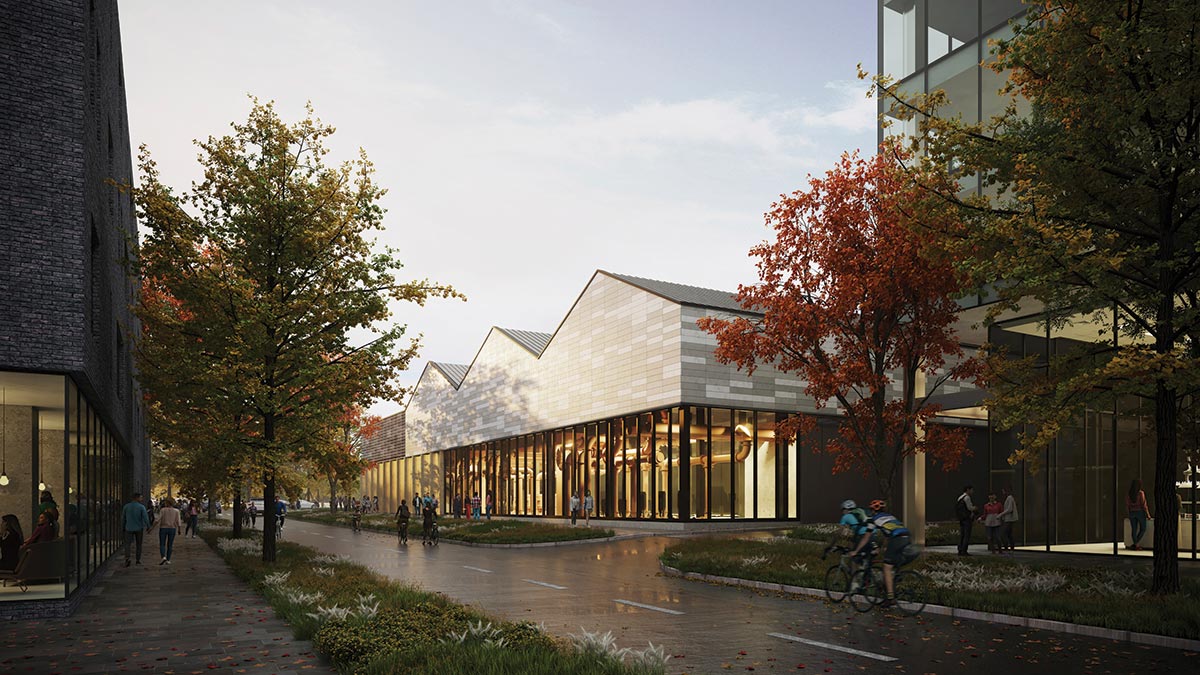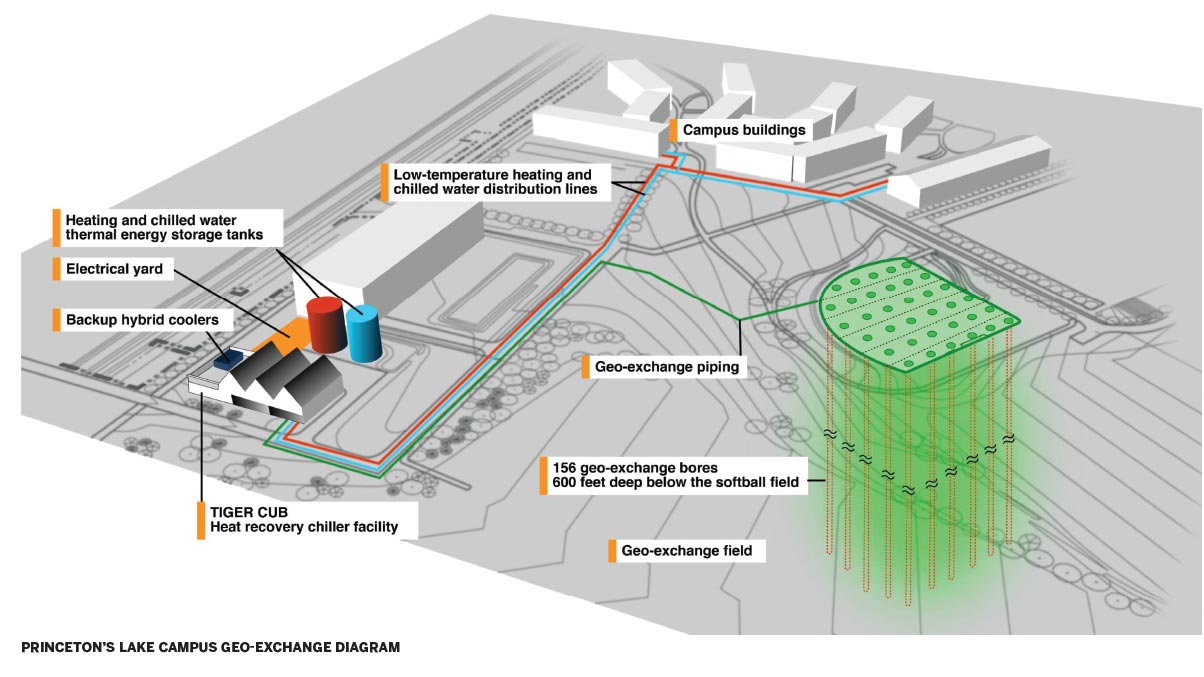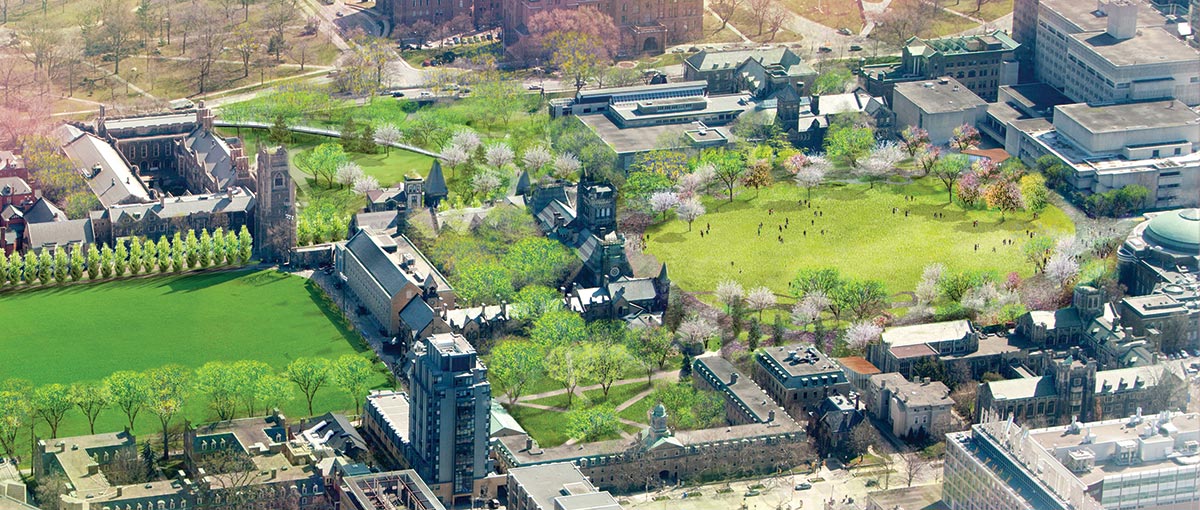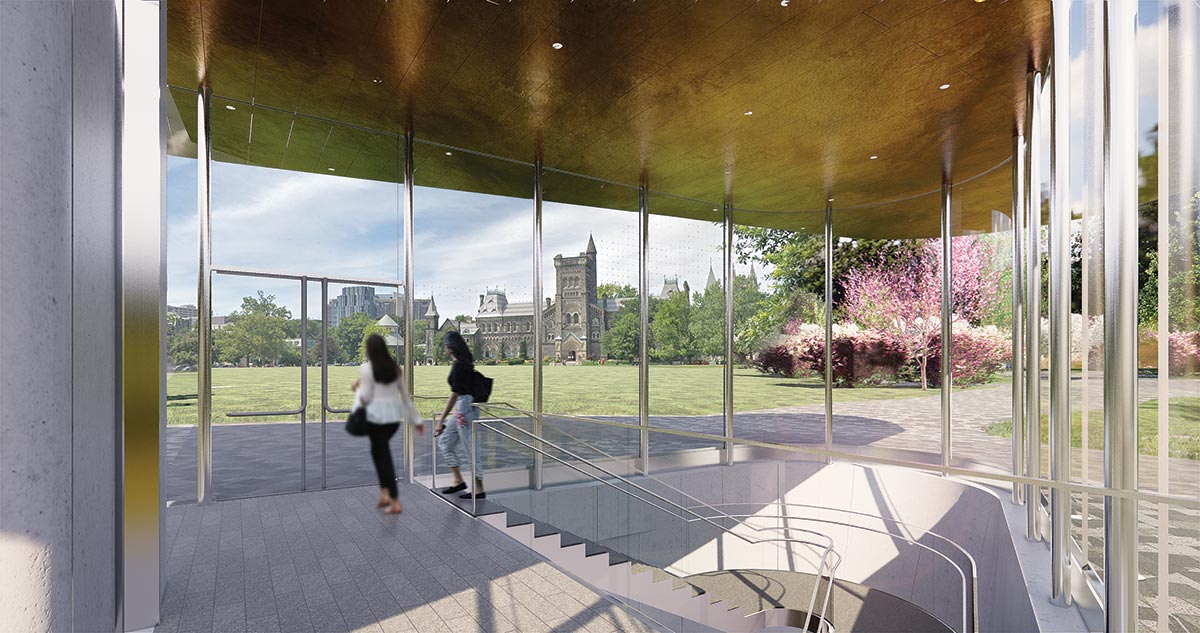View course on architecturalrecord.com »

IMAGE: COURTESY ZGF
Expanses of glazing allow passersby to see the colorful infrastructure housed within the TIGER facility on Princeton’s main campus.
Anyone whose university residence was heated by steam probably remembers well the nighttime clanging and banging of pipes. But in addition to those noisy nights, steam systems depend on combustible fuel, making them one of the biggest obstacles to reducing carbon emissions that universities with ambitious climate goals typically face. Now, however, the days of fossil fuel-based heating and cooling may be numbered—a growing cohort of schools is pioneering district energy systems based on geo-exchange instead.
Geo-exchange takes advantage of the fact that, below the frost line, the ground holds a fairly steady temperature. (In the northern United States, it’s about 45 to 50 degrees Fahrenheit, and in the southern U.S., it’s about 50 to 70.) Because heat wants to move from warmer molecules to cooler ones, surplus building heat can be conducted into the ground during hot weather, and ground heat can be extracted when it’s colder up top. And if you’re thinking 50 degrees in winter is no good to anyone, here’s the kicker: the magic of heat pumps and compressors is that they amplify the base temperature, producing levels of heat (or, in summer, cooling) that are all that’s needed to maintain comfortable indoor temperatures. Returning three to four units of energy for each unit of electricity used to operate them, geo-exchange systems are widely considered to be the most efficient, environmentally clean, and cost-effective space conditioning available today.
At its simplest, a geo-exchange system consists of buried pipe loops, a heat pump, and distribution pipes. The buried pipes can be laid horizontally, in a shallow configuration, or, where more capacity is needed within a constrained footprint, vertically, hundreds of feet deep. (In vertical installations, borehole thermal energy storage [BTES] can bank summer’s heat for months in supplementary thermal masses installed in the ground.) The heat pump circulates a fluid—often water, sometimes a refrigerant—through the buried pipes to stash or retrieve heat, amplifying the differentials. The distribution pipes deliver heating and cooling where they’re needed. Assuming clean electricity operates the pump, it’s a zero-carbon setup.

IMAGE: COURTESY ZGF/ATCHAIN
The utility building for the geo-exchange system on Princeton’s new campus responds to its more pastoral setting with gabled roofs.
RECORD recently checked in on three university projects that are integrating geo-exchange into their campus energy infrastructure. Princeton University, whose system features prominent new utility buildings completed this year by ZGF Architects, is aiming to become carbon neutral in time for the institution’s 300th anniversary, in 2046. The University of Toronto—taking advantage of a major upgrade designed by KPMB Architects and Michael Van Valkenburgh Associates (MVVA) to the landscape of its historic central campus—is installing a geo-exchange system (now under construction) to advance its goal of becoming carbon positive by 2050. Colorado Mesa University, which first installed geo-exchange in 2007 and is on track to become the first all-geo campus in the U.S., is serving as a living lab for researchers and advocates seeking to improve the understanding and uptake of this emissions-free energy.
“It’s not a new technology. What’s new is the infrastructure overhaul at this scale,” says Maryam Katouzian, a principal at ZGF Architects. Building on its success with geo-exchange for individual buildings, Princeton’s new 1,200-bore district-energy system consists of two drill fields with bores up to 850 feet deep, one on the university’s main campus and the other on its new campus across Carnegie Lake, in West Windsor, New Jersey. Each drill field has an associated utility building that houses heat pumps, chillers, and electrical equipment, and two tanks that store heated and chilled water ready for circulation.
On Princeton’s densely built main campus, locating these facilities presented both a challenge and an opportunity. The drill fields themselves are sited beneath playing fields and a parking garage. The utility buildings, instead of being tucked away, are prominently located at campus gateways. “From the beginning, our approach was that Princeton is at the forefront of this technology, and we need to use these buildings as showcases,” Katouzian says. “It was an architectural strategy.”
The form of each building differs in response to its context. The one on the main campus—known by the acronym TIGER (thermally integrated geo-exchange resource) in a reference to Princeton’s mascot—takes a long, horizontal form, and is wrapped in box rib metal panels and capped with a glazed clerestory. The new campus’s facility—known as TIGER CUB (central utility building)—responds to its more pastoral setting with gabled, barnlike roofs and terra-cotta cladding. The storage tanks have been half-sunken to bring them into scale with their surroundings. At both buildings, the landscape architecture directs passersby along the facades, where expanses of glazing invite the curious to peer in and discover colorful, annotated pipes explaining the system at work. Inviting and rewarding curiosity was a key goal for the design, says Katouzian: “These facilities need to serve as teaching opportunities and help to put this technology out there.”

IMAGE COURTESY INTROBA
Princeton’s Lake Campus Geo-Exchange Diagram

IMAGE COURTESY ZGF
Princeton Tiger Cub system diagram
With this project complete, Princeton plans to convert its natural gas–powered, steam-based cogeneration plant (chilled water and combined heat and electricity) to geo-powered hot water, linking it to TIGER so the two can partially back each other up. The conversion will also include the installation of more than 13 miles of new underground distribution pipes suitable for the lower temperatures of geo-exchange. (These will replace the thermally inefficient steam-compatible ones.) By 2046, according to Princeton’s master plan, all of the university’s more than 180 buildings will convert to geo-exchange and other renewables, offering what ZGF describes as “a compelling example of how infrastructure projects can advance missions, embody values, and create distinct identity for the institutions they serve.”
Central to the identity of the University of Toronto, both literally and figuratively, are 20 acres of linked landmark green spaces defining its historic downtown campus. A consortium of KPMB and MVVA has designed a major upgrade to this landscape to become a more completely walkable realm of granite pathways, gardens, and trees. Cars, which for decades have been jamming up the heritage precinct of King’s College Circle, will be relegated to a below-grade parking garage. And, under the garage, 800 feet deep and more, a new 370-bore drill field will supply energy to replace steam heating for the new and existing buildings of the central campus.
One of architects’ most vital yet unsung roles is coordination, and that was especially true for KPMB on this project, says Shirley Blumberg, a founding partner of the firm. Close coordination of the geotechnical and structural engineers’ designs was needed to ensure that bore holes were drilled in compliance with the garage’s final grade and clear of future footings. Intensifying the challenge, value engineering reduced the structural interval to the point where, in order to steer clear of the increased number of footings while still accommodating the required number of boreholes, some along the perimeter had to be drilled at an angle. Complicating the job even further, existing underground infrastructure and tunnels presented “a lot of interesting surprises,” says Blumberg.

IMAGES: COURTESY KPMB ARCHITECTS
While revamping King’s College Circle, the University of Toronto is building new below-grade parking entered via a transparent pavilion (below). A 370-bore drill field is under the garage.
View course on architecturalrecord.com »

IMAGE: COURTESY ZGF
Expanses of glazing allow passersby to see the colorful infrastructure housed within the TIGER facility on Princeton’s main campus.
Anyone whose university residence was heated by steam probably remembers well the nighttime clanging and banging of pipes. But in addition to those noisy nights, steam systems depend on combustible fuel, making them one of the biggest obstacles to reducing carbon emissions that universities with ambitious climate goals typically face. Now, however, the days of fossil fuel-based heating and cooling may be numbered—a growing cohort of schools is pioneering district energy systems based on geo-exchange instead.
Geo-exchange takes advantage of the fact that, below the frost line, the ground holds a fairly steady temperature. (In the northern United States, it’s about 45 to 50 degrees Fahrenheit, and in the southern U.S., it’s about 50 to 70.) Because heat wants to move from warmer molecules to cooler ones, surplus building heat can be conducted into the ground during hot weather, and ground heat can be extracted when it’s colder up top. And if you’re thinking 50 degrees in winter is no good to anyone, here’s the kicker: the magic of heat pumps and compressors is that they amplify the base temperature, producing levels of heat (or, in summer, cooling) that are all that’s needed to maintain comfortable indoor temperatures. Returning three to four units of energy for each unit of electricity used to operate them, geo-exchange systems are widely considered to be the most efficient, environmentally clean, and cost-effective space conditioning available today.
At its simplest, a geo-exchange system consists of buried pipe loops, a heat pump, and distribution pipes. The buried pipes can be laid horizontally, in a shallow configuration, or, where more capacity is needed within a constrained footprint, vertically, hundreds of feet deep. (In vertical installations, borehole thermal energy storage [BTES] can bank summer’s heat for months in supplementary thermal masses installed in the ground.) The heat pump circulates a fluid—often water, sometimes a refrigerant—through the buried pipes to stash or retrieve heat, amplifying the differentials. The distribution pipes deliver heating and cooling where they’re needed. Assuming clean electricity operates the pump, it’s a zero-carbon setup.

IMAGE: COURTESY ZGF/ATCHAIN
The utility building for the geo-exchange system on Princeton’s new campus responds to its more pastoral setting with gabled roofs.
RECORD recently checked in on three university projects that are integrating geo-exchange into their campus energy infrastructure. Princeton University, whose system features prominent new utility buildings completed this year by ZGF Architects, is aiming to become carbon neutral in time for the institution’s 300th anniversary, in 2046. The University of Toronto—taking advantage of a major upgrade designed by KPMB Architects and Michael Van Valkenburgh Associates (MVVA) to the landscape of its historic central campus—is installing a geo-exchange system (now under construction) to advance its goal of becoming carbon positive by 2050. Colorado Mesa University, which first installed geo-exchange in 2007 and is on track to become the first all-geo campus in the U.S., is serving as a living lab for researchers and advocates seeking to improve the understanding and uptake of this emissions-free energy.
“It’s not a new technology. What’s new is the infrastructure overhaul at this scale,” says Maryam Katouzian, a principal at ZGF Architects. Building on its success with geo-exchange for individual buildings, Princeton’s new 1,200-bore district-energy system consists of two drill fields with bores up to 850 feet deep, one on the university’s main campus and the other on its new campus across Carnegie Lake, in West Windsor, New Jersey. Each drill field has an associated utility building that houses heat pumps, chillers, and electrical equipment, and two tanks that store heated and chilled water ready for circulation.
On Princeton’s densely built main campus, locating these facilities presented both a challenge and an opportunity. The drill fields themselves are sited beneath playing fields and a parking garage. The utility buildings, instead of being tucked away, are prominently located at campus gateways. “From the beginning, our approach was that Princeton is at the forefront of this technology, and we need to use these buildings as showcases,” Katouzian says. “It was an architectural strategy.”
The form of each building differs in response to its context. The one on the main campus—known by the acronym TIGER (thermally integrated geo-exchange resource) in a reference to Princeton’s mascot—takes a long, horizontal form, and is wrapped in box rib metal panels and capped with a glazed clerestory. The new campus’s facility—known as TIGER CUB (central utility building)—responds to its more pastoral setting with gabled, barnlike roofs and terra-cotta cladding. The storage tanks have been half-sunken to bring them into scale with their surroundings. At both buildings, the landscape architecture directs passersby along the facades, where expanses of glazing invite the curious to peer in and discover colorful, annotated pipes explaining the system at work. Inviting and rewarding curiosity was a key goal for the design, says Katouzian: “These facilities need to serve as teaching opportunities and help to put this technology out there.”

IMAGE COURTESY INTROBA
Princeton’s Lake Campus Geo-Exchange Diagram

IMAGE COURTESY ZGF
Princeton Tiger Cub system diagram
With this project complete, Princeton plans to convert its natural gas–powered, steam-based cogeneration plant (chilled water and combined heat and electricity) to geo-powered hot water, linking it to TIGER so the two can partially back each other up. The conversion will also include the installation of more than 13 miles of new underground distribution pipes suitable for the lower temperatures of geo-exchange. (These will replace the thermally inefficient steam-compatible ones.) By 2046, according to Princeton’s master plan, all of the university’s more than 180 buildings will convert to geo-exchange and other renewables, offering what ZGF describes as “a compelling example of how infrastructure projects can advance missions, embody values, and create distinct identity for the institutions they serve.”
Central to the identity of the University of Toronto, both literally and figuratively, are 20 acres of linked landmark green spaces defining its historic downtown campus. A consortium of KPMB and MVVA has designed a major upgrade to this landscape to become a more completely walkable realm of granite pathways, gardens, and trees. Cars, which for decades have been jamming up the heritage precinct of King’s College Circle, will be relegated to a below-grade parking garage. And, under the garage, 800 feet deep and more, a new 370-bore drill field will supply energy to replace steam heating for the new and existing buildings of the central campus.
One of architects’ most vital yet unsung roles is coordination, and that was especially true for KPMB on this project, says Shirley Blumberg, a founding partner of the firm. Close coordination of the geotechnical and structural engineers’ designs was needed to ensure that bore holes were drilled in compliance with the garage’s final grade and clear of future footings. Intensifying the challenge, value engineering reduced the structural interval to the point where, in order to steer clear of the increased number of footings while still accommodating the required number of boreholes, some along the perimeter had to be drilled at an angle. Complicating the job even further, existing underground infrastructure and tunnels presented “a lot of interesting surprises,” says Blumberg.

IMAGES: COURTESY KPMB ARCHITECTS
While revamping King’s College Circle, the University of Toronto is building new below-grade parking entered via a transparent pavilion (below). A 370-bore drill field is under the garage.

From a design perspective, the most challenging decisions revolved around how pedestrians enter and exit the underground garage, given its location beneath a central green. (Cars will come and go via one of the circle’s original access routes, sloped for the change in level.) With so many significant heritage buildings framing the lawn, the architect located a glazed entrance pavilion in front of a Brutalist medical-sciences building set back from the circle. Highly transparent, with slender steel columns, the pavilion is designed to preserve views for pedestrians approaching the circle from the building. Similarly, exit stairs have been discreetly located around the periphery. From the stairs of the entry pavilion, large windows into the geo-exchange mechanical room will showcase the equipment it takes to run the system. The space is also designed for teaching and demonstrations.
Geo-exchange is expected to reduce the university’s emissions by the equivalent of 15,000 metric tons of carbon dioxide per year, making it the single biggest contributor to the institution’s annual reduction target of 44,567 metric tons. At the same time, the project is demonstrating the viability of the technology for retrofitting existing and historic buildings at scale in a tight urban context. “That’s the relevance of this,” says Blumberg. “There’s a massive urgency as the climate crisis speeds up, and one hopes that in the not-too-distant future, all buildings will be built with renewable energy.”
The experience of Colorado Mesa University (CMU), an early adopter of geo-exchange, suggests that the hope is not unrealistic. A 125-acre campus in Grand Junction, Colorado, CMU completed its first bore field in 2007, in response to a state requirement for all new publicly funded buildings to achieve LEED Gold certification. The subsequently expanded system now provides heating and cooling for 16 academic and auxiliary buildings totaling 1.2 million square feet. It supplies 90 percent of the energy the campus needs to operate, saves the university some $1.5 million in heating and cooling costs each year, and has reduced the carbon footprint of the campus by about 17,750 metric tons of CO₂ annually. Some of the nearly $12 million that CMU has saved since 2008 has been shared with students in the form of reduced tuition increases.

PHOTOGRAPHY: COURTESY COLORADO MESA UNIVERSITY
Colorado Mesa University’s geo-exchange system uses its swimming pool as a heat sink.
“The most basic principle of our system is that it allows us to move heat energy across campus,” says Kent Marsh, CMU’s vice president of capital planning, sustainability, and campus operations. For example, at the beginning of November, single-occupancy offices on the north side of a classroom building will be calling for heat, while a full lecture hall with ample glazing on the south side of the building will still need cooling. “Our system allows us to grab that excess heat from the lecture hall and simply move it to the offices on the north side,” says Marsh. “That’s the basic transfer, what we call ‘least-energy path.’ ”
The system can also transfer surplus heat to another floor, or pipe it to another building altogether via a central loop 5 feet below grade. If heat isn’t needed in any of those places, it’s sent to a heat sink, such as the university’s 800,000 gallon swimming pool or the domestic hot-water preheating system. If there’s energy left over after those uses—and with Grand Junction’s summer temperatures hitting 100 degrees-plus for weeks on end, there often is—it gets stashed in one of eight bore fields for retrieval when the seasons change.
Over the course of the system’s 15 or so years of operation, some lessons have emerged. One is that smaller loops within the larger system help distribute energy more efficiently. That’s because the rate of heat transfer is highest when temperature difference, known as ∆T (delta T), is greatest. If a loop is pulling heat from building after building, there comes a point when there isn’t enough ∆T between the water in the loop and the next overheated building for heat to transfer effectively. Better instead to have a smaller number of buildings on a smaller loop, collect the heat, dump it in a nearby sink or drill field, and send the cooled water around again (or, in winter, the reverse).
The other discovery has been that a thorough understanding of how heat is translated among various uses doesn’t necessarily exist yet, says Marsh. “As I connect a new building, I monitor the temperature of our loop pipe,” he explains. “When the water in that loop gets too warm, then I know that we’ve connected too much load to the system, and I need another drill field or another sink to dump some of that waste heat.” CMU is now collaborating with researchers to make this process operate less through trial and error by developing ways to quantify how much heat from a building of a certain occupancy type, size, and heating or cooling load can be transferred to meet other needs.
Continuing to expand what is already one of the largest geo-exchange systems in North America, CMU has recently secured funding to complete the connection of the campus’s remaining 14 buildings. The drilling and infrastructure are expected to be largely finished next summer, with building connections to be completed in the following two to three years. Beyond that, Marsh wonders what the potential is for expanding the campus system to the broader community—to serve a new high school now being built across the street, for example, or a municipal swimming pool a quarter mile away. “When you think about this in the broader context of decarbonization,” he asks, “could, one day, a municipality that provides sewer and water services, or an energy utility that provides gas and electricity, provide a geo-resource in the same way?”
Taking notice of the potential that CMU’s system represents, the governor of Colorado has become an advocate for what he has tagged “the heat beneath our feet” across Colorado and among the Western states. In Canada, even before its system is complete, the University of Toronto has already exposed thousands of students of multiple disciplines to the potential of geo-exchange—a form of advocacy that may well have greater impact than the system itself. In New Jersey, the architectural treatment and prominence that Princeton has given its system is a similarly powerful form of advocacy. As a growing number of campuses convert their systems, it’s not unreasonable to hope that geo-exchange-based district energy will gather steam—and eventually replace it too.
Supplemental Materials:
“District Energy Systems Overview”, U.S. Department of Energy, September 2020.



















